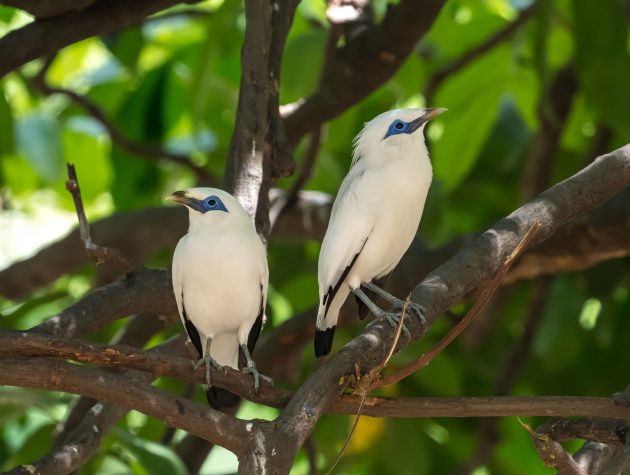
Somehow, I had never given a trip to Bali much thought, imagining it to be mostly about sunshine, beaches, and partying – not exactly my scene. But on a birding trip to East Java, I ended up just a few kilometers by ferry from Bali and thus decided to visit Bali Barat National Park.

The main attraction for birders there – the title of the post gives it away – is the Bali Myna, a Bali endemic that was first described only in 1911. It is a Critically Endangered species – at some point, apparently only 6 individuals lived in the wild, though there are about 1000 captive individuals. This also hints at the reason for the status – it is a species that was heavily trapped.

Most recently, the situation seems to have improved a bit, as outlined in a recent paper. One of the reasons for the improvement is a scheme that allowed the breeding facility of Bali Barat National Park to loan captive birds to local communities for commercial breeding. The aim was to flood the market with captive-bred birds, thus reducing their price and in turn the incentives for poachers.

Another factor is a changed approach by the National Park Authority -from concentrating efforts on the protected areas with suboptimal habitat towards human-dominated areas with a landscape more aligned with the species’ requirements (extensive short grass cover and open forests rather than dense woodland). It seems grass is important even if you dislike humans.


Nestboxes also help. A total of 76 Bali Mynas fledged in the Bali Barat area in 2020, which the authors of a paper say offers “grounds for cautious optimism”.


Given that probably still more Bali Mynas live in captivity than in the wild, it is unsurprising that several research papers also cover captive birds. At the Saint Louis Zoo, three pairs of young Bali Mynas pluck neck feathers from conspecifics. Maybe out of boredom? To find out, the birds were presented with seven novelty items (not singing plastic fish as in The Sopranos – rather, some bamboo tube devices). Unfortunately, this did not reduce the plucking – but the birds moved around more and reduced other behaviors such as autopreening, allogrooming, and head bobbing.

Another paper – also with captive birds – looked at the neophobia (fear of anything new) of Bali Mynas. Unfortunately, the researchers seem to have lost the ability to form straightforward sentences in a mistaken effort to sound scientific:

“We found effects of condition and presence of heterospecifics, including longer latencies to touch familiar food in presence than absence of novel items, and between problem-solving tasks, as well as in the presence of non-competing heterospecifics than competing heterospecifics. Age influenced neophobia, with adults showing longer latencies than juveniles. Individuals were repeatable in latency responses: (1) temporally in both experiments; (2) contextually within the innovation experiment and between experiments, as well as being consistent in approach order across experiments, suggesting stable behaviour traits. “

Ok, so it seems that adults have a greater fear of new things than juveniles … and it was not so hard for me to come up with this sentence (even though admittedly it only describes part of the results presented in the paragraph above).


(ChatGPT, upon my question for a newly created word describing the fear of being easily understood, suggests “Luciphobia” and “Clariphobia”)


One paper even finds a link between climate change and the decline of the Bali Myna: “This study discovers that increases in temperature and precipitation each year have adversely affected the number of Bali Myna population indicating that the bird’s survival capacity depends largely much (sic!) on temperature” – a claim that sounds reasonable but is unlikely to be supported by solid data given the many other parameters affecting the species’ survival.

Critics of the Bali Myna highlight their bad parenting, as in this paper. Fortunately, in captive birds, this can be improved via changes in enclosure design, enrichment, and feeding patterns.


The scientific name of the Bali Myna, Leucopsar rothschildi, honors Walter Rothschild, 2nd Baron Rothschild, a member of the Rothschild banking family. Apparently, at the age of seven, he already declared that he would run a zoological museum but at 21, he was forced to work at the family bank. With limited success: “He evidently lacked any interest or ability in the financial profession, but it was not until 1908, at the age of 40, that he was finally allowed to give it up” (source).

Finally, in the wild, what do the birds do all day? At Bali Barat National Park, their main activities are flying 17%, fruit feeding 3%, insect feeding 1%, preening 15%, cresting head 6%, bobbing 7%, singing 40%, drinking 0,5%, and walking 10% (source). Somehow, the time budget for bad parenting is not included.














Such a lovely bird. Great to read about one of my favourites.
Aku sukakan warna nya
A beautiful bird, I’ve only seen a captive one in a zoo in Japan, thanks for the great insight and information. Great to learn more about these birds.